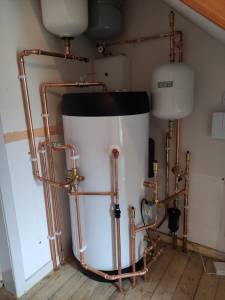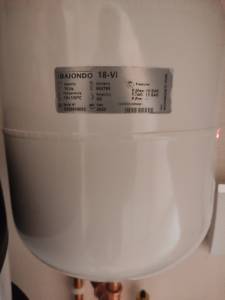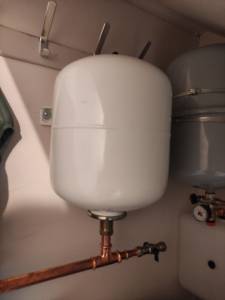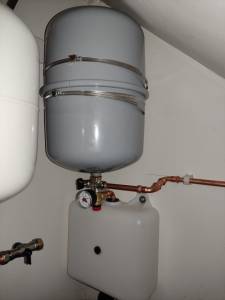Volumiser placement in Vaillant Arotherm + system?
Hi guys,
I had a Vaillant Arotherm + 7KW installed last week and an trying to get some snagging issues resolved with the installer. I posted on a Vaillant Facebook group and got loads of feedback and yes the lagging is getting sorted! One thing people couldn't agree on was whether the volumiser on the right was in the correct place, or necessary at all and I wondered it anyone on here had any opinions?
The installer said it may have been left on from a Daikin schematic, because that pump was poor at defrosting, but this one is better and that they would be happy to remove it when they come to do other snagging jobs on Friday. I thought I would seek advice on here before I made a decision. The volumiser is the white tank on the right and I believe the grey tank is a 20/25L buffer.
Very happy to have had my pump installed as we have moved from a coal burning multifuel stove, but I am keen to get it as efficient as possible before the installers move on to the next job!
Heat pump is only doing DHW at the moment - 200L tank set at 45C achieving a rough COP of 3.5. Volumiser gets warm to touch.
Best,
Rob
It is difficult to identify from a photo what task each vessel is performing, but the ones in question look more like expansion vessels rather than volumiser or buffer tank.
Can you provide a close-up photo of the nameplate on each device?
Hi Derek,
Thanks for taking a look.
This is the one on the right hand side.
There is no label on the white vessel on the left but it looks to me as if it is probably this:
(Ignore the second photo)
The grey one in the middle doesn't have a label but I think I remember seeing a box with 25L buffer vessel written on it somewhere.
Don't know if that helps at all?
Best,
Rob
The vessel with the nameplate would appear to be the following, which may be being used to add volume to your system. Is it connected within the pipework from your heat pump.
http://www.spatec.co.uk/shop/viewitem.php?productid=680
The white and grey vessels appear to be expansions vessels for the primary and secondary water systems. Their purpose is to allow expansion and contraction of the water within the systems due to change in temperature. They should both have a nameplate which may be round the back or on top.
After having a closer look at your original photo, I think that your system is piped up as follows:-
The pipe coming through the floor furthest on the right would appear to be the flow pipe from your heat pump. This feeds up to the tee where it branches via the horizontal pipe to the electrically operated 3 port valve.
The vertical pipe coming out of the top of the 3 port valve connects to the heating coil within the hot water cylinder. The return pipe from the heating coil connects to a tee near the base of the hot water cylinder.
Pipework from this tee is connected to the bottom connection on the volumiser tank. The top connection on this tank is connected to the return pipe to your heat pump via the filter unit. The outlet from the volumiser tank is also connected to the grey expansion vessel.
The bottom port of the 3 port valve is connected to the flow pipe to the heat emitters and disappears into the floor. The return pipe from the heat emitters connects to the tee feeding back to the heat pump via the volumiser tank.
The mains water supply is via the left most pipe coming through the floor. This feeds into the Pressure Reducing Valve (PRV), after which there is pipework connected to the white expansion vessel and also to the bottom of the hot water cylinder. The pipework feeding out of the hot water cylinder is mounted on the top.
To decide whether to remove the volumiser tank or not, you would need to calculate the volume of water within your heating system, and confirm that this volume is greater than the minimum volume specified in the heat pump manual. Leaving the volumiser in place should not be too detrimental even if it is decided that it is no longer required.
Thanks for the run through Derek. So it seems as though it's in the correct position? I think I'll leave it in place and add a bit of insulation around it.
Had a look a the min system volume for defrost cycle for the Arotherm 7kw and it's 55L. I believe our heating system is over 130L so it does seem as if the volumiser is over kill.
@wobby1 thanks for this - yes his advice was reassuring and system is working very well. I was a bit worried after loads of people had pointed out issues with the install on a Facebook group so I thought I would double check on here. Piping has all been lagged now too.
Posted by: @rob-k@wobby1 thanks for this - yes his advice was reassuring and system is working very well. I was a bit worried after loads of people had pointed out issues with the install on a Facebook group so I thought I would double check on here. Piping has all been lagged now too.
I do believe that the 'knowledge' level on facebook can be a dangerous thing. 😋
The bypass is not installed correctly, as it should incorporate the volumizer, which it doesn't.
-
My house is too big and the Vaillant 7kW heat pump can't heat it when temperatures drop below 4C
10 months ago
-
High air source heat pump running costs – Vaillant AroTherm Plus
10 months ago
-
Vaillant arotherm plus heat pump frost protection
11 months ago
-
Air source heat pump problems - NIBE F 2040 ASHP
12 months ago
-
Vaillant aroTHERM plus not level or flat - what base is best under an external unit?
1 year ago
- 26 Forums
- 2,367 Topics
- 53.7 K Posts
- 1,019 Online
- 6,042 Members
Join Us!
Worth Watching
Latest Posts
-
-
RE: Who's your electricity provider and what's your tariff?
@majordennisbloodnok This may be a better thread to ...
By Batpred , 10 hours ago
-
RE: Help needed with Grant Aerona 3 issues
Noted. Its a pity you didnt capture the flow rate and ...
By JamesPa , 15 hours ago
-

RE: Best Heat Pump Brand in the UK
Last Call to Vote & Win! Haven't voted for your Hea...
By Mars , 15 hours ago
-

RE: Solis S6-EH1P8K-L-PLUS – Why I Chose It and What I’ve Learned So Far
Interesting question. To be frank, since I have no inte...
By Majordennisbloodnok , 22 hours ago
-
RE: Changing from 4-port buffer to volumizer
@andy1618 see the very sage advice from @editor above. ...
By JamesPa , 1 day ago
-
RE: New Fogstar 15.5kWh upright solution
The video shows the JK balancer, but the connection of ...
By Batpred , 1 day ago
-
RE: Ecodan unable to hit legionella target temp - what's the consensus?
@9jwr9 Hi, yes this is the issue with every (stand alon...
By ASHP-BOBBA , 1 day ago
-
RE: Help me keep the faith with my air source heat pump installation
@adamk FWIW I managed unintentionally to 'coax' mine in...
By JamesPa , 2 days ago
-
RE: Octopus Cosy Heat Pump Owners & Discussion Thread
You are in essence right. Adia only works with selecte...
By JamesPa , 2 days ago
-

No, you haven’t missed out, @batpred. This thread’ll st...
By Majordennisbloodnok , 2 days ago
-

RE: Tesla Powerwall – More of a ‘Luxury’ Than an ROI Winner!
Also, though they weren’t prepared to match the price t...
By Toodles , 2 days ago
-
RE: How long will your energy contract last?
My INTELLI-FIX-12M-25-08-29 has less than 12 months to ...
By Batpred , 2 days ago
-

RE: GivEnergy 2025 forthcoming batteries and inverters
Then, perhaps @toodles , you should've made a submissio...
By Transparent , 2 days ago
-
RE: Balancing financial efficiency and comfort using the Octopus Cosy tariff
I am wondering if anyone with an EV could find the 7p/k...
By Batpred , 2 days ago
-
Possibly, but it would also reduce DeltaT across the em...
By JamesPa , 2 days ago
-

RE: ASHP sizing - value of Heat Transfer Coefficient
@cathoderay It was reminiscent of the BBC Open Universi...
By Toodles , 2 days ago
-
-

@morgan They are unsupervised these days, can’t get the...
By Toodles , 5 days ago









